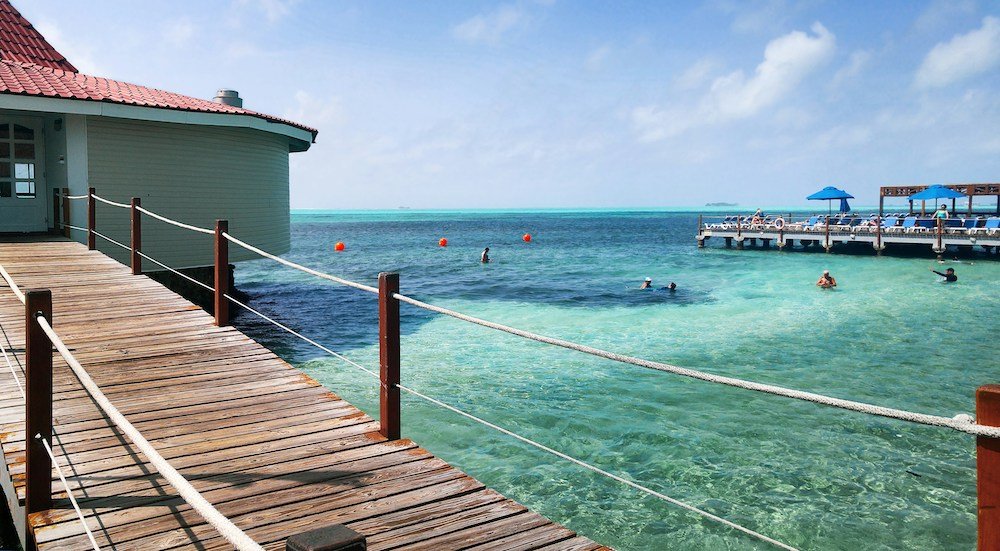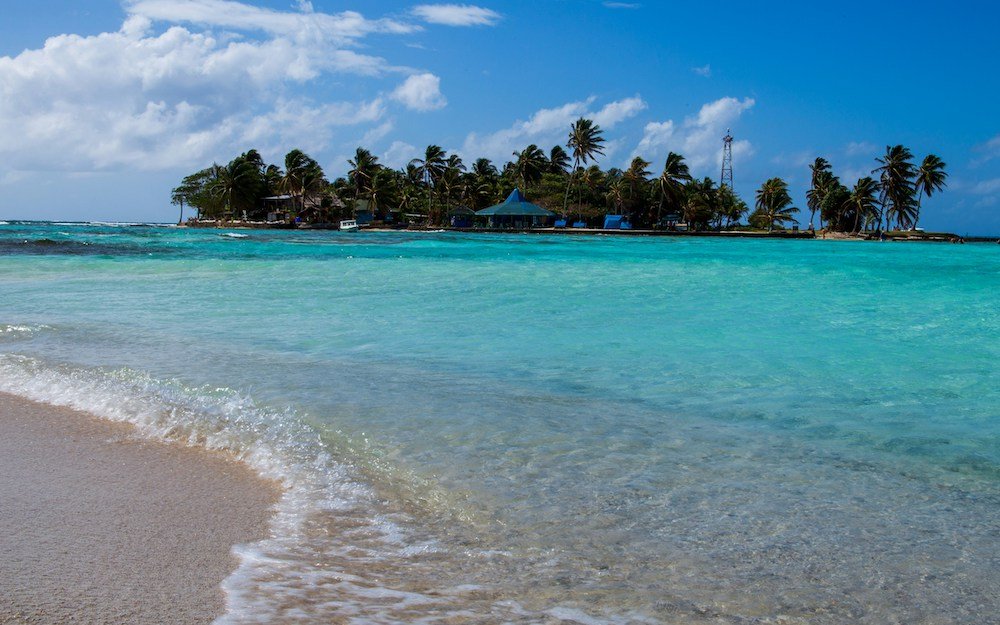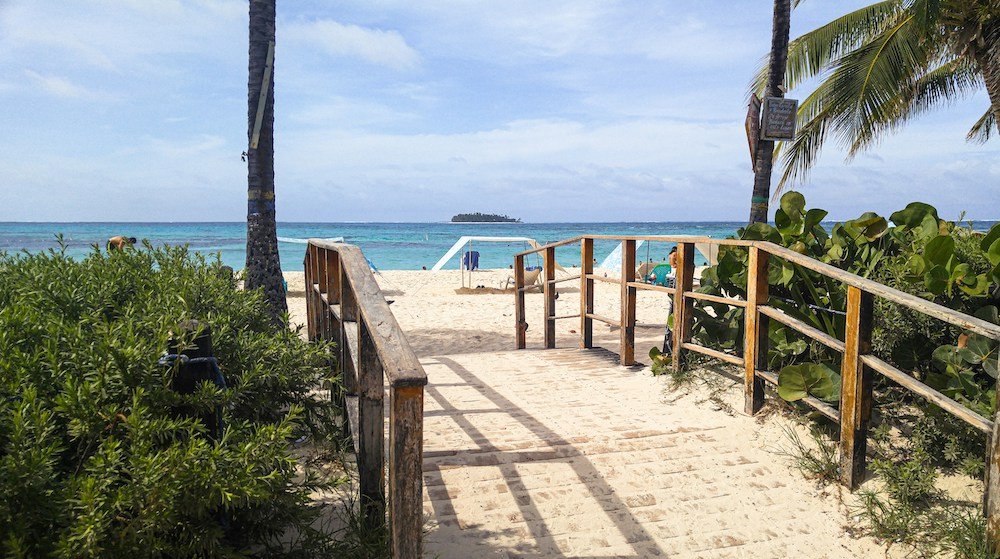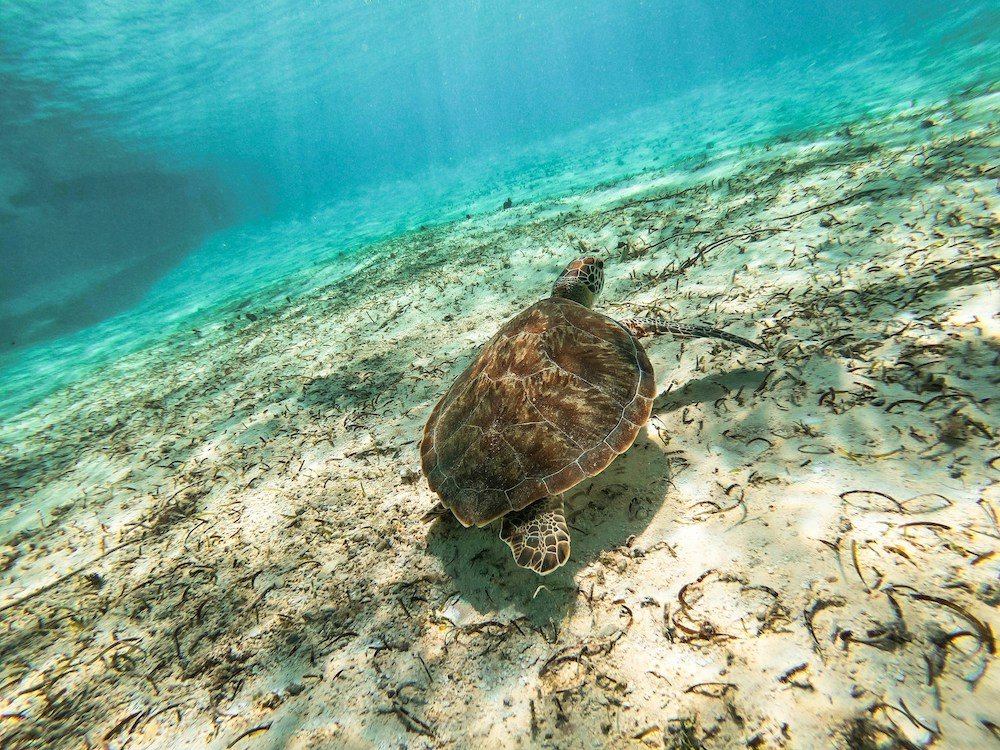
San Andrés Island, a jewel in the Caribbean Sea, beckons travelers with its pristine beaches, turquoise waters, and vibrant culture.
This guide aims to unravel the enchanting allure of San Andrés Island, offering insights into its diverse attractions, activities, and local experiences.
Nestled in the western Caribbean Sea, San Andrés Island is a Colombian treasure renowned for its stunning landscapes and rich history.
The island, along with its smaller companions, Providencia and Santa Catalina, forms part of the San Andrés Archipelago.
With its idyllic beaches, diverse marine life, and captivating cultural heritage, San Andrés Island promises an unforgettable tropical getaway.
Travelers flock to its shores for relaxation, adventure, and exploration, drawn by the island’s natural beauty and warm hospitality.
This guide serves as a comprehensive resource for visitors planning a trip to San Andrés Island.
Whether you seek sun-drenched beaches, thrilling water sports, or authentic Colombian cuisine, this guide aims to provide invaluable insights, tips, and recommendations to enhance your island experience.
From practical travel advice to insider tips on hidden gems, embark on a journey to discover the wonders of San Andrés Island.
Location and Geography

San Andrés Island’s captivating location and geographical features set the stage for an unforgettable tropical escape.
From its strategic position in Colombia to its diverse landscapes and climate, the island offers a paradise unlike any other.
Overview of San Andrés Island’s Location in Colombia
Situated in the western Caribbean Sea, San Andrés Island is part of the San Andrés Archipelago, which is an overseas department of Colombia.
Despite its proximity to Nicaragua and Jamaica, San Andrés Island is officially Colombian territory and boasts a unique blend of Caribbean and Colombian cultures.
Geographical Features and Climate
San Andrés Island features a diverse range of geographical attractions, including pristine beaches, lush forests, and rugged hills.
The island’s climate is tropical, characterized by warm temperatures year-round and occasional rainfall, particularly during the rainy season from May to November.
Trade winds moderate the climate, making San Andrés Island an ideal destination for sun-seekers and outdoor enthusiasts alike.
Unique Natural Attractions
San Andrés Island is home to a myriad of natural wonders waiting to be explored.
From the crystal-clear waters of Johnny Cay to the breathtaking vistas of Morgan’s Cave, the island boasts an array of unique attractions.
Visitors can marvel at the vibrant coral reefs of West View, hike through the verdant landscapes of La Loma, or relax on the powdery sands of San Luis Beach.
With its diverse ecosystems and stunning vistas, San Andrés Island offers endless opportunities for adventure and discovery.
Getting There

Getting to San Andrés Island is the first step towards an unforgettable Caribbean adventure.
Whether by air or sea, various transportation options connect travelers to this tropical paradise, offering convenience and accessibility.
Transportation Options (Air, Sea)
Travelers to San Andrés Island have the option of arriving by air or sea.
While air travel is the most common and convenient method, some adventurous souls may opt for a more scenic journey via boat or ferry.
Airports and Airlines Serving San Andrés
Gustavo Rojas Pinilla International Airport (ADZ) is the primary gateway to San Andrés Island, welcoming flights from mainland Colombia and select international destinations.
Several airlines offer regular flights to San Andrés Island, including Avianca, LATAM Airlines, and Viva Air, providing travelers with a range of options to suit their preferences and budgets.
Travel Tips and Considerations
- Booking in Advance: Due to the island’s popularity, it’s advisable to book flights and accommodations well in advance to secure the best deals and availability.
- Travel Documents: Ensure you have all necessary travel documents, including a valid passport and any required visas or permits for entry into Colombia.
- Baggage Restrictions: Be mindful of baggage restrictions imposed by airlines, particularly for domestic flights within Colombia.
- Arrival Procedures: Familiarize yourself with arrival procedures at Gustavo Rojas Pinilla International Airport, including customs and immigration requirements.
- Local Transportation: Upon arrival, consider transportation options from the airport to your accommodation, such as taxis, shuttle services, or rental cars.
- Weather Considerations: Check weather forecasts and potential travel disruptions, especially during the rainy season, to plan your trip accordingly.
Accommodation

Choosing the right accommodation is essential for a comfortable and enjoyable stay on San Andrés Island.
From luxury resorts to budget-friendly hostels, the island offers a variety of options to suit every traveler’s preferences and budget.
Types of Accommodations Available
San Andrés Island boasts a diverse range of accommodations, catering to the needs and preferences of various travelers. Options include:
- Hotels: Luxury resorts and boutique hotels offer upscale amenities and personalized services, perfect for travelers seeking a pampering retreat.
- Resorts: All-inclusive resorts provide convenience and comfort, with amenities such as pools, spas, and dining options onsite.
- Hostels: Budget-conscious travelers can opt for hostels and guesthouses, offering affordable accommodations and opportunities to connect with fellow travelers.
- Vacation Rentals: Vacation rentals, including apartments and villas, provide a home-away-from-home experience, ideal for families or groups seeking privacy and flexibility.
Popular Areas to Stay on the Island
San Andrés Island features several popular areas for accommodation, each offering its own unique charm and attractions:
- San Andrés Town: The island’s main town, San Andrés Town, boasts a bustling atmosphere, with a wide range of accommodations, restaurants, and shops. Its central location provides easy access to beaches, attractions, and nightlife.
- Spratt Bight Beach: Located near San Andrés Town, Spratt Bight Beach is a popular tourist hub, offering a vibrant seaside atmosphere and a variety of accommodations overlooking the turquoise waters.
- San Luis: Situated on the island’s southern coast, San Luis offers a more tranquil and laid-back atmosphere, with pristine beaches and picturesque landscapes. Accommodations range from beachfront resorts to cozy guesthouses.
- Rocky Cay: Rocky Cay is known for its serene beaches and coral reefs, making it a popular choice for snorkeling and diving enthusiasts. Accommodations in this area offer a peaceful retreat amidst stunning natural surroundings.
Budget Considerations and Booking Tips
- Seasonal Rates: Be mindful of seasonal rates, with peak tourist seasons typically coinciding with school holidays and major festivals. Consider visiting during the off-peak season for potential savings.
- Booking Platforms: Utilize online booking platforms and travel websites to compare prices, read reviews, and secure the best deals on accommodations.
- Flexible Dates: Consider flexibility in travel dates to take advantage of promotional offers and last-minute discounts.
- Amenities and Inclusions: When comparing accommodations, consider the value of included amenities such as breakfast, Wi-Fi, and recreational facilities.
- Early Booking: Book accommodations well in advance, especially during peak seasons, to ensure availability and secure preferred room types.
Things to Do

San Andrés Island offers a plethora of activities and attractions to suit every traveler’s interests and preferences.
From sun-soaked beaches to thrilling water sports and cultural experiences, the island promises endless opportunities for adventure and relaxation.
Beaches and Water Activities
San Andrés Island is renowned for its pristine beaches and crystal-clear waters, perfect for swimming, sunbathing, and water sports. Top beaches include:
- Spratt Bight Beach: The island’s main beach, bustling with activity and lined with palm trees, offering opportunities for swimming, beach volleyball, and water sports rentals.
- San Luis Beach: A tranquil stretch of white sand beach on the island’s southern coast, ideal for relaxation and snorkeling amidst vibrant coral reefs.
- Rocky Cay: A picturesque islet connected to San Andrés Island by a sandy pathway, featuring shallow waters and excellent snorkeling conditions.
Water activities abound, including snorkeling, scuba diving, kayaking, jet skiing, and parasailing, allowing visitors to explore the island’s vibrant marine life and stunning underwater landscapes.
Snorkeling and Diving Spots
San Andrés Island is a paradise for snorkeling and diving enthusiasts, with an abundance of coral reefs, shipwrecks, and marine life to explore. Popular snorkeling and diving spots include:
- La Piscinita: A natural swimming pool teeming with colorful fish and coral formations, offering excellent snorkeling opportunities for beginners and experienced enthusiasts alike.
- The Blue Hole: A captivating dive site renowned for its crystal-clear waters, dramatic rock formations, and diverse marine species, including rays, turtles, and reef sharks.
- The Seaflower Biosphere Reserve: A protected marine area surrounding San Andrés Island, home to an array of coral reefs, seagrass beds, and mangrove forests, offering unparalleled diving experiences.
Land-Based Activities
Beyond its beaches and waters, San Andrés Island boasts a wealth of land-based activities for visitors to enjoy. Explore lush landscapes, historic landmarks, and scenic viewpoints through:
- Hiking: Embark on scenic hikes along nature trails and coastal pathways, such as the trail to Morgan’s Cave or the hike to the peak of La Loma for panoramic views of the island.
- Biking: Rent a bicycle and explore the island at your own pace, traversing scenic routes and discovering hidden gems along the way.
- Sightseeing: Discover the island’s rich cultural heritage through visits to historic sites, such as La Loma Church, the Old Point Lighthouse, and the San Andrés Botanical Garden.
Cultural Experiences and Local Attractions
Immerse yourself in San Andrés Island’s vibrant culture and traditions through:
- Local Markets: Explore bustling markets and artisan stalls, such as the San Andrés Public Market and the Raizal Market, where you can sample local delicacies, purchase handicrafts, and interact with friendly locals.
- Cultural Festivals: Experience the island’s vibrant festivals and celebrations, such as the Festival of the Sea and the Miss San Andrés Pageant, showcasing traditional music, dance, and cuisine.
Nightlife and Entertainment Options
As the sun sets, San Andrés Island comes alive with vibrant nightlife and entertainment venues, offering live music, dance performances, and beachfront parties. Popular nightlife spots include:
- Coco Loco: A beachfront bar and nightclub known for its lively atmosphere, tropical cocktails, and dance floor overlooking the sea.
- Sunset Parties: Join locals and fellow travelers for sunset parties on the beach, featuring music, bonfires, and breathtaking views of the Caribbean Sea.
Dining and Cuisine

San Andrés Island tantalizes the taste buds with its rich culinary heritage and diverse array of flavors.
From traditional island delicacies to international cuisine, visitors can savor a culinary journey that reflects the vibrant culture and history of the Caribbean.
Overview of Local Cuisine
San Andrés Island’s culinary scene is a melting pot of influences, blending indigenous, African, Spanish, and Caribbean flavors to create a unique and diverse gastronomic experience.
Key ingredients include fresh seafood, tropical fruits, coconut, and spices, resulting in dishes bursting with color and flavor.
Popular Dishes and Where to Find Them
- Rondón: A hearty seafood stew made with coconut milk, plantains, yams, and a variety of fresh seafood, including fish, shrimp, and crab. Look for rondón at local restaurants and beachfront eateries.
- Lobster: San Andrés Island is renowned for its succulent lobster dishes, often served grilled, fried, or in savory sauces. Head to seafood restaurants along the coast, such as El Pescadero, for delicious lobster specialties.
- Patacones: Fried green plantains flattened and topped with cheese, shrimp, or meat, patacones are a popular snack or side dish found at street vendors and local eateries.
- Coco Bread: Soft and fluffy bread infused with coconut milk, perfect for enjoying with savory or sweet fillings. Look for coco bread at bakeries and snack shops throughout the island.
- Ceviche: A refreshing seafood dish made with raw fish marinated in lime juice and mixed with onions, peppers, and cilantro. Sample ceviche at seafood restaurants and beachfront bars, such as La Regatta.
Restaurants and Dining Options for Various Budgets
San Andrés Island offers dining options to suit every budget and palate, ranging from casual eateries to upscale restaurants overlooking the Caribbean Sea.
- Budget-Friendly Options: For wallet-friendly dining, explore local markets and street food stalls offering affordable and authentic dishes, such as empanadas, arepas, and fresh fruit juices.
- Mid-Range Restaurants: Discover cozy cafes and family-run restaurants serving home-cooked meals and traditional island fare at reasonable prices. Look for restaurants in San Andrés Town and along the beachfront promenade.
- Fine Dining Establishments: Indulge in a memorable dining experience at upscale restaurants and gourmet eateries, where chefs showcase the island’s finest ingredients and culinary techniques. Reserve a table at restaurants like Restaurante La Barracuda or Restaurante El Pescador for exquisite seafood dishes and ocean views.
Shopping

San Andrés Island beckons shoppers with its vibrant markets, quaint boutiques, and eclectic array of local crafts and souvenirs.
Whether seeking unique handicrafts, tropical keepsakes, or stylish beachwear, visitors will find plenty of shopping opportunities to indulge their senses and bring a piece of the Caribbean home.
Overview of Shopping Opportunities on San Andrés Island
San Andrés Island offers a diverse shopping scene, catering to a variety of tastes and preferences.
From bustling markets to boutique shops, visitors can explore a treasure trove of goods, including clothing, jewelry, artwork, and local specialties.
Local Crafts, Souvenirs, and Specialty Items
- Handmade Crafts: Discover intricate handcrafted items made by local artisans, including woven baskets, wood carvings, and pottery, showcasing the island’s rich cultural heritage.
- Sea-inspired Jewelry: Adorn yourself with unique jewelry pieces inspired by the Caribbean Sea, featuring shells, pearls, and colorful gemstones crafted into earrings, necklaces, and bracelets.
- Colombian Coffee: Sample and purchase aromatic Colombian coffee beans, renowned for their rich flavor and smooth texture, available at specialty coffee shops and markets throughout the island.
- Rum and Liquors: Take home a taste of the Caribbean with locally produced rums and liquors, including flavored rum infusions and tropical fruit liqueurs, perfect for enjoying on the beach or as gifts for friends and family.
Tips for Bargaining and Best Places to Shop
- Bargaining Tips: When shopping at markets and street stalls, don’t be afraid to haggle for the best price. Start with a friendly negotiation and be prepared to walk away if the price isn’t right.
- Best Places to Shop: Explore the bustling San Andrés Public Market for a wide selection of fresh produce, seafood, and local delicacies, as well as handicrafts and souvenirs. For unique artisanal goods and stylish boutiques, wander along the streets of San Andrés Town and the beachfront promenade.
- Beachside Vendors: Keep an eye out for beachside vendors selling handmade jewelry, sarongs, and souvenirs along popular beaches such as Spratt Bight Beach and Rocky Cay.
- Quality vs. Price: While it’s tempting to opt for the cheapest option, consider the quality and authenticity of the items you’re purchasing. Invest in well-crafted souvenirs and artisanal goods that reflect the true spirit of San Andrés Island.
Practical Tips and Advice

Before embarking on your journey to San Andrés Island, it’s essential to familiarize yourself with practical tips and advice to ensure a safe, enjoyable, and culturally enriching experience.
From safety considerations to local customs, these insights will help you navigate the island with confidence and respect.
Safety and Security Considerations
- Beach Safety: Exercise caution when swimming or participating in water activities, as strong currents and rip tides can pose risks, especially during rough weather conditions.
- Sun Protection: Protect yourself from the sun’s intense rays by wearing sunscreen, hats, and sunglasses, and seeking shade during peak hours.
- Petty Theft: Keep valuables secure and be vigilant of pickpockets and petty theft, particularly in crowded tourist areas and beaches.
- Emergency Contacts: Familiarize yourself with emergency contact numbers and the location of the nearest police station and medical facilities in case of emergencies.
Health and Medical Facilities
- Travel Insurance: Consider purchasing travel insurance to cover medical emergencies, trip cancellations, and other unforeseen circumstances during your stay.
- Medical Facilities: San Andrés Island is equipped with medical clinics, hospitals, and pharmacies to provide essential healthcare services to residents and visitors.
- Water Safety: Drink bottled or purified water to avoid gastrointestinal illnesses, and be cautious of consuming raw or undercooked foods.
Language and Communication
- Spanish Language: While Spanish is the official language of Colombia, many locals in San Andrés Island also speak English, especially in tourist areas and hospitality establishments.
- Basic Phrases: Learning a few basic Spanish phrases can enhance your travel experience and facilitate communication with locals, who appreciate efforts to engage in their language and culture.
Currency and Banking Information
- Colombian Peso (COP): The official currency of Colombia is the Colombian Peso (COP). ATMs are available in San Andrés Town for currency exchange and cash withdrawals.
- Credit Cards: Major credit cards such as Visa and Mastercard are widely accepted at hotels, restaurants, and shops in tourist areas. However, it’s advisable to carry cash for smaller transactions and in more remote areas of the island.
E. Local Customs and Etiquette
- Respect Local Customs: Embrace the local customs and traditions of San Andrés Island, including greetings, dining etiquette, and social norms.
- Dress Code: Respect cultural norms by dressing modestly when visiting religious sites and local communities.
- Tipping: Tipping is appreciated but not always expected in San Andrés Island. Consider leaving a gratuity for exceptional service at restaurants and for tour guides.
Day Trips and Excursions

Exploring beyond San Andrés Island unveils a world of natural wonders, cultural treasures, and adventurous experiences waiting to be discovered.
From nearby islands to organized tours, day trips offer opportunities for unforgettable adventures and memorable discoveries.
Nearby Islands and Attractions
- Providencia Island: Embark on a day trip to Providencia Island, a pristine paradise renowned for its tranquil beaches, lush landscapes, and vibrant coral reefs. Highlights include the UNESCO-listed Old Town, Crab Cay Natural Park, and the mesmerizing views from The Peak.
- Santa Catalina Island: Discover the secluded beauty of Santa Catalina Island, a tranquil retreat offering secluded beaches, excellent snorkeling spots, and opportunities for hiking and birdwatching.
- Johnny Cay: Take a boat excursion to Johnny Cay, a small coral island known for its powdery white sands, swaying palm trees, and turquoise waters. Enjoy swimming, sunbathing, and snorkeling amidst breathtaking natural surroundings.
Organized Tours and Excursions
- Snorkeling Tours: Join guided snorkeling tours to explore the island’s vibrant coral reefs and marine life, including popular spots like La Piscinita, West View, and El Hoyo Soplador.
- Island Safari Tours: Embark on an island safari tour to explore San Andrés Island’s hidden gems and natural attractions, including rugged landscapes, historic sites, and panoramic viewpoints.
- Boat Excursions: Cruise around the island on a boat excursion, visiting secluded beaches, hidden coves, and snorkeling hotspots accessible only by boat.
Tips for Planning Day Trips
- Research and Book in Advance: Research available day trips and excursions and book in advance to secure your spot, especially during peak tourist seasons.
- Pack Essentials: Bring essential items such as sunscreen, hats, swimsuits, towels, and water bottles to stay comfortable during day trips.
- Follow Local Guidelines: Respect local regulations and guidelines when visiting natural reserves, marine parks, and protected areas to minimize environmental impact and preserve fragile ecosystems.
- Be Flexible: Be prepared for changes in weather and itinerary during day trips, and maintain a flexible attitude to make the most of unexpected opportunities and discoveries.
Sustainable Tourism and Responsible Travel

As visitors to San Andrés Island, it is essential to embrace sustainable practices and responsible travel behaviors to preserve the island’s natural beauty, cultural heritage, and community well-being.
By adopting environmentally conscious habits and supporting local initiatives, travelers can contribute to the long-term sustainability and resilience of San Andrés Island.
Environmental Preservation Efforts
- Marine Conservation: Support marine conservation efforts aimed at preserving the island’s coral reefs, marine biodiversity, and coastal ecosystems. Participate in beach clean-up initiatives and refrain from disturbing coral reefs and marine life during snorkeling and diving activities.
- Waste Management: Dispose of waste responsibly by recycling, reducing single-use plastics, and properly disposing of trash in designated bins. Follow the principles of “leave no trace” and carry out any litter brought to beaches or natural areas.
- Energy Conservation: Conserve energy and water resources by opting for eco-friendly accommodations, minimizing water usage, and turning off lights and air conditioning when not in use.
Tips for Minimizing Environmental Impact as a Visitor
- Choose Sustainable Transportation: Opt for eco-friendly transportation options such as walking, biking, or using public transit to explore the island and minimize carbon emissions.
- Conserve Water and Energy: Practice water and energy conservation habits, such as taking shorter showers, reusing towels, and turning off lights and air conditioning when leaving your accommodation.
- Respect Wildlife: Observe wildlife from a safe distance and avoid feeding or touching animals to prevent disruption to their natural behaviors and habitats.
Supporting Local Communities and Businesses
- Shop Local: Support local artisans, businesses, and markets by purchasing handmade crafts, souvenirs, and locally sourced products. Seek out authentic cultural experiences and interact with local residents to gain insight into their way of life.
- Respect Local Customs: Respect the traditions, customs, and beliefs of the local community by dressing modestly, learning basic phrases in Spanish, and adhering to cultural norms and etiquette.
- Engage in Responsible Tourism Practices: Choose tour operators and accommodations that prioritize sustainability, community engagement, and environmental stewardship. Seek out eco-friendly tours and experiences that promote conservation and support local initiatives.
Conclusion
San Andrés Island, a tropical paradise in the heart of the Caribbean Sea, captivates visitors with its stunning landscapes, vibrant culture, and warm hospitality.
As you embark on your journey to this enchanting destination, embracing the spirit of adventure and exploration, it’s essential to approach your experience with mindfulness, respect, and a commitment to sustainability.
Throughout this guide, we’ve explored the myriad attractions, activities, and practical considerations for visiting San Andrés Island:
- Location and Geography: Discover the island’s unique geographical features and climate, along with its diverse natural attractions.
- Accommodation and Dining: Explore various accommodation options and savor the flavors of local cuisine, from traditional seafood dishes to tropical delights.
- Activities and Excursions: Delve into the array of activities and day trips available, from beach relaxation to snorkeling adventures and cultural experiences.
- Practical Tips and Advice: Navigate your journey with confidence, considering safety, health, communication, currency, and cultural etiquette.
- Sustainable Tourism: Embrace sustainable practices and responsible travel behaviors to minimize environmental impact and support local communities.
Final Tips and Recommendations for Visiting San Andrés Island
- Embrace Island Time: Slow down, relax, and immerse yourself in the laid-back island lifestyle, savoring each moment and cherishing the natural beauty that surrounds you.
- Explore Off the Beaten Path: Venture beyond the tourist hotspots to discover hidden gems, secluded beaches, and authentic cultural experiences that offer glimpses into the soul of San Andrés Island.
- Connect with Nature: Take time to reconnect with nature, whether snorkeling amidst vibrant coral reefs, hiking through lush rainforests, or simply basking in the beauty of a stunning sunset over the Caribbean Sea.
- Engage with Locals: Engage with local residents, learn about their customs, traditions, and way of life, and forge meaningful connections that transcend language and cultural barriers.
- Leave a Positive Impact: Leave a positive impact on San Andrés Island by practicing sustainable tourism principles, supporting local businesses, and leaving behind only footprints and memories.

FAQ’s About San Andrés Island
Is it worth visiting San Andrés?
Absolutely!
San Andrés Island offers a stunning blend of natural beauty, vibrant culture, and exciting activities.
From its pristine beaches to its rich marine life, there’s something for everyone to enjoy on this tropical paradise.
What country owns San Andrés island?
San Andrés Island is part of Colombia, making it a Colombian territory.
It’s located in the western Caribbean Sea and is part of the San Andrés Archipelago, along with Providencia and Santa Catalina islands.
Why is San Andrés famous?
San Andrés is famous for its breathtaking beaches with powdery white sands and crystal-clear turquoise waters.
It’s also renowned for its vibrant coral reefs, making it a top destination for snorkeling and diving enthusiasts.
How do you get to San Andrés island?
The primary way to reach San Andrés Island is by air.
Gustavo Rojas Pinilla International Airport (ADZ) serves as the main gateway, offering flights from mainland Colombia and select international destinations.
How many days do you need in San Andrés?
The ideal duration for a trip to San Andrés depends on your preferences and interests. Many visitors find that spending around 4-7 days allows enough time to explore the island’s attractions, enjoy water activities, and relax on its beautiful beaches.
Is San Andrés a party island?
While San Andrés offers some nightlife and entertainment options, it’s not primarily known as a party island like some other destinations in the Caribbean.
Visitors can enjoy beachfront bars, live music, and occasional events, but the island generally offers a more laid-back atmosphere.
Is it safe to go to San Andrés at night?
Generally, San Andrés is considered safe for visitors at night. However, as with any destination, it’s essential to remain vigilant and aware of your surroundings, especially in tourist areas and during late hours.
Is there a fee to enter San Andrés island?
There is no specific fee to enter San Andrés Island.
However, visitors may need to pay certain fees for activities, tours, and entrance to attractions during their stay on the island.
Do people live on San Andrés island?
Yes, San Andrés Island is home to a permanent population of residents.
The island has a diverse community, including descendants of African slaves, indigenous groups, and Colombian settlers. These residents contribute to the island’s rich cultural heritage and traditions.





